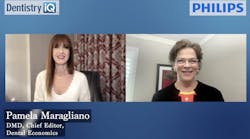Trends in direct access dental hygiene: Vulnerable populations and game-changing 2018 CDT codes
I grew up in Burns, a small rural farming town in Eastern Oregon, where the nearest town was over 70 miles away, and medical and dental care was limited to a few local providers. My hometown is not unique in that aspect, and in places like these, it’s not unusual for residents to have to either wait months for an appointment or travel to a nearby larger city for care. A provider shortage can jeopardize patient health. As dental professionals, how can we increase access while providing quality care?
After graduating, leaving my little hometown, and experiencing the larger world, I realized the scope of the hurdles to medical and dental care that rural parts of the country face on a daily basis. For many individuals, travelling elsewhere for care is simply not an option due to socioeconomic factors. Lack of access can increase emergency room visits and increase poor treatment outcomes. If some areas had increased access to preventative care then maybe, just maybe, we could help prevent or limit emergency care. With an eye on the oral-systemic link, finding the balance of access and education for our population is puzzling.
In larger cities, it seems like dental offices are like drug stores—there’s one on almost every corner. Even so, some patients struggle to make it to dental appointments to receive care. Some patients are not only limited by their location; cost and mobility and disability issues can inhibit the ability to receive even basic care.
The state of direct access care
The dental hygienist’s role, as explained by many outside of the profession, has been nothing more than picking, scraping, and rubbing that “little swirly thing” around. Well, times are changing, and dental care trends change, too. The American Dental Hygienists’ Association (ADHA) defines direct access care as the ability (1) of a hygienist to initiate treatments based on assessment of his or her patient’s needs without the specific authorization of a dentist, (2) to treat the patient without the presence of a dentist, and (3) to maintain a provider-patient relationship. In 2017, a grand total of 40 states have approved direct access care in a various degree of duties, up from 28 in 2008. We are making strides toward independent care, but are still well behind the curve of recognition of what nurse practitioners are to the medical community. The ADHA is dedicated to providing a voice for us all and changing the old stereotypes to develop a strong and knowledgeable group of professionals dedicated to serve the dental community.
Emerging in our field is the role of the dental therapist, essentially a midlevel practitioner who can provide care to a wide range of individuals, including underserved and rural populations. Some states have now approved duties that a therapist can perform under indirect or general supervision. For example, in Minnesota, a dental therapist may extract severely periodontally involved teeth, perform a pulpotomy, and provide emergency palliative treatment as necessary to alleviate pain, among other approved treatments. When I think about my little hometown, I reflect on how the ability to have a dental therapist would greatly benefit residents, many of whom are at or below poverty level, and alleviate the pressure on local dentists to see all patients needing care. At this time, only a small handful of states have approved the practice model and implemented the state practice act to allow care, and I hope many states will soon follow this trend. In our vast country there are areas that could greatly benefit from the expertise of dental therapists.
The impact on the elderly population
Dental therapists, public health hygienists, and extended access or direct care can also reach out to the patient population that seems to disappear over time, the elderly. In years of practice, I have personally had patients that no longer preschedule or attend a dental visit due to the fact they are no longer able to drive themselves or have limited mobility. Once they are in an assisted living facility or using a walker or wheelchair, the ability to get to appointments becomes more difficult. There have been more times than I am able to count that an elderly patient is reluctant to schedule due to the fear they will be an inconvenience a loved one by asking for a ride, and often the dental appointments take a back seat to their many medical visits. I have personally taken the time to pick up and return a few select patients to their homes to assure they are able to receive the care they need and desire. Now this is not and shouldn’t be the norm; however, they were long-term elderly patients that I enjoyed just visiting personally. However, this example proves the point that just because they have a need, it doesn’t always follow that they have a method of transportation.
The trend of direct access care allows a hygienist in many states to treat the elderly patients in an assisted living or nursing home setting with general supervision or collaboration that does not require the dentist to be on site. Often our elderly are the forgotten population who often need dental care the most. They generally live with generally poor oral hygiene and multiple systemic conditions, and medications they take often carry the biggest risk for oral side effects. I know hygienists who have created a business from their passion of helping the elderly and now treat patients outside of the traditional clinical setting.
Caring for those in the silver years should be more important now than ever, as we are living longer and in general keeping our dentition longer than the generation before. Multiple studies show that when a person loses the ability to chew and eat well, overall health declines. There are some hygienists that have created very successful models of treatment providing direct access care to homebound patients or those who rarely are able to leave a hospital bed. Improving the quality of life from the aspect of oral care in the final years of life’s journey can be a small thing that means so much not only to the patient but also relieves the burden on his or her loved ones. I look at the good that some of my colleagues throughout the country have accomplished with pride, and when speaking with these hygienists, find that they report this type of care is mutually beneficial for the hygienists and patient.
As a mother of an autistic child with special needs, I know wellsome of the challenges that new environments bring, the ability to control some factors of patient care be a blessing that reduces stress on all parties involved. Autism is not a cookie-cutter disorder and affects everyone differently, but a commonly challenge for these patients is a change in routine and or being introduced to unfamiliar environments. With the ability to provide direct access care, I have been able to see some special-needs patients in unconventional environments or when the doctor is out of the office to limit external stimuli to the patient. For the families of special-needs patients it can make the day just a little easier and the patient more willing and often able to get the needed treatment.
New CDT codes that are changing things
In 2018, new CDT codes will change the way dental care is accessed in rural communities from coast to coast with teledentistry. With the advances in teledentistry and direct access care, we now have a tool to allow patients in underserved and rural areas to obtain care and a diagnosis via teledentistry. The new CDT codes recognize not only D9995 (synchronous [real time] teledentistry), but also provide the ability to track D9996 (asynchronous teledentistry), which is stored or forwarded to the dentist for review. Teledentistry is a good way to increase practice production without adding to a dental practice's space or adding chairs, and it serves a purpose for not only patient-provider relationships—it can also be implemented between dental and medical professionals to collaborate as necessary.
Dental hygienists are making leaps and bounds, progressing our profession by creating avenues for direct access care that didn’t exist a decade ago. With the support of the ADHA as a voice of advancement and the grassroots efforts of the Dental Hygienists’ Coding Focus Group to recommend changes in the way the dental profession utilizes CDT codes we are bound to grow, develop, and impact the world around us.
Editor's note: This article first appeared in RDH eVillage. Click here to subscribe.
Jamie Collins, RDH, CDA, resides in Idaho with her husband, Cory, and their four children. She currently works as a full-time hygienist as well as an educator at the College of Western Idaho. In addition, she acts as a content expert and contributor in multiple upcoming textbooks. She can be contacted at [email protected].
About the Author

Jamie Collins, BS, RDH-EA
Jamie Collins, BS, RDH-EA, is a clinical practicing hygienist in Idaho and Washington states. She has been in the dental field for nearly 20 years, both as an assistant and hygienist. With a passion for patient care, especially those with higher risk factors, Jamie enjoys sharing the tips and tricks of dental profession through speaking and writing. In addition to clinical practice Jamie is also an educator, has contributed to multiple textbooks and curriculum development, and contributes as a key opinion leader. Jamie can be contacted at [email protected].



